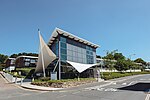Estover, Plymouth
Estover is a district in Devon, England, within the Plymouth boundary area. The original hamlet was extensively developed during the 1970s, into what became back then a large housing estate, consisting almost entirely of council houses (constructor: Wimpey Homes), situated five miles northeast of Plymouth city centre in the English county of Devon. The majority of the houses are now privately owned. Estover also annexes an industrial estate. It has two schools, Tor Bridge High (formerly Estover Community college) and Tor Bridge Primary, both of which are situated along Miller Way. Estover has one public house, the Jolly Miller. Associated Dairies opened their very first, and large Asda superstore in southern England in Estover in 1976. The industrial estate is home to, amongst others, a Wrigley Company Limited factory.A satellite photo of Estover, provided by Google Maps can be found here.
Excerpt from the Wikipedia article Estover, Plymouth (License: CC BY-SA 3.0, Authors).Estover, Plymouth
Miller Way, Plymouth Estover
Geographical coordinates (GPS) Address Phone number Website Nearby Places Show on map
Geographical coordinates (GPS)
| Latitude | Longitude |
|---|---|
| N 50.41 ° | E -4.1 ° |
Address
Tor Bridge Primary School
Miller Way
PL6 8EE Plymouth, Estover
England, United Kingdom
Open on Google Maps




